Thermoelectric Generator Design and Characterization for Industrial Pipe Waste Heat Recovery
Abstract
1. Introduction
2. Design and Development of the TEG
2.1. Generating Performance of TEM
2.2. TEG Design and Experiment Platform Build
3. Results and Discussion
3.1. Analysis of Hot End Uniformity
3.2. Topological Structure of TEMs
3.3. Influence of Cooling Water Velocity on Generating Performance
3.4. Influence of Hot and Cold End Temperature on Generating Performance
3.5. The Thermal Resistance Distribution of TEG
3.6. Voltametric Characterization of TEG
4. Conclusions
Author Contributions
Funding
Data Availability Statement
Acknowledgments
Conflicts of Interest
Nomenclature
| TEG | Thermoelectric generator |
| TEM | Thermoelectric device |
| Voc | Open–circuit voltage |
| Pmax | Maximum output power |
| Th | Hot end temperature |
| Tc | Cold end temperature |
| vw | Water velocity |
| η | Conversion efficiency |
| Qout | Electrical energy generated by the TEG |
| Qin | Heat energy flow through the TEG |
| PW | Power of the water temperature increase |
| C | Specific heat capacity of the water |
| ΔTW | Temperature difference of the inlet and outlet water |
| t | Unit time with value for 1s |
| mW | Mass of the water |
| ρW | Density and flow of the water |
| QW | Flow of the water |
References
- Remeli, M.F.; Tan, L.; Date, A.; Singh, B.; Akbarzadeh, A. Simultaneous power generation and heat recovery using a heat pipe assisted thermoelectric generator system. Energy Convers. Manag. 2015, 91, 110–119. [Google Scholar] [CrossRef]
- Attar, A.; Lee, H.; Weera, S. Experimental Validation of the Optimum Design of an Automotive Air–to–Air Thermoelectric Air Conditioner (TEAC). J. Electron. Mater. 2015, 44, 2177–2185. [Google Scholar] [CrossRef]
- Sakdanuphab, R.; Sakulkalavek, A. Design, empirical modeling and analysis of a waste–heat recovery system coupled to a traditional cooking stove. Energy Convers. Manag. 2017, 139, 182–193. [Google Scholar] [CrossRef]
- Stijepovic, M.Z.; Linke, P. Optimal waste heat recovery and reuse in industrial zones. Energy 2011, 13, 341–363. [Google Scholar]
- Miró, L.; Brückner, S.; Cabeza, L.F. Mapping and discussing Industrial Waste Heat (IWH) potentials for different countries. Renew. Sustain. Energy Rev. 2015, 51, 847–855. [Google Scholar] [CrossRef]
- Huang, F.; Zheng, J.; Baleynaud, J.M.; Lu, J. Heat recovery potentials and technologies in industrial zones. J. Energy Inst. 2017, 90, 951–961. [Google Scholar] [CrossRef]
- Jang, J.-C.; Chi, R.-G.; Rhi, S.-H.; Lee, K.-B. Heat Pipe–Assisted Thermoelectric Power Generation Technology for Waste Heat Recovery. J. Electron. Mater. 2015, 44, 2039–2047. [Google Scholar] [CrossRef]
- Orr, B.; Akbarzadeh, A.; Mochizuki, M.; Singh, R. A review of car waste heat recovery systems utilising thermoelectric generators and heat pipes. Appl. Therm. Eng. 2016, 101, 490–505. [Google Scholar] [CrossRef]
- Kim, T.Y.; Negash, A.A.; Cho, G. Experimental study of energy utilization effectiveness of thermoelectric generator on diesel engine. Energy 2017, 128, 531–539. [Google Scholar] [CrossRef]
- Jaziri, N.; Boughamoura, A.; Müller, J.; Mezghani, B.; Tounsi, F.; Ismail, M. A comprehensive review of Thermoelectric Generators: Technologies and common applications. Energy Rep. 2020, 6, 264–287. [Google Scholar] [CrossRef]
- Suter, C.; Jovanovic, Z.R.; Steinfeld, A. A 1kWe thermoelectric stack for geothermal power generation–Modeling and geometrical optimization. Appl. Energy 2012, 99, 379–385. [Google Scholar] [CrossRef]
- Weng, C.-C.; Huang, M.-J. A study of using a thermoelectric generator to harvest energy from a table lamp. Energy 2014, 76, 788–798. [Google Scholar] [CrossRef]
- Özdemir, A.E.; Köysal, Y.; Özbaş, E.; Atalay, T. The experimental design of solar heating thermoelectric generator with wind cooling chimney. Energy Convers. Manag. 2015, 98, 127–133. [Google Scholar] [CrossRef]
- Al-Nimr, M.d.A.; Tashtoush, B.M.; Jaradat, A.A. Modeling and simulation of thermoelectric device working as a heat pump and an electric generator under Mediterranean climate. Energy 2015, 90, 1239–1250. [Google Scholar] [CrossRef]
- Børset, M.T.; Wilhelmsen, Ø.; Kjelstrup, S.; Burheim, O.S. Exploring the potential for waste heat recovery during metal casting with thermoelectric generators: On–site experiments and mathematical modeling. Energy 2017, 118, 865–875. [Google Scholar] [CrossRef]
- Yazawa, K.; Shakouri, A.; Hendricks, T.J. Thermoelectric heat recovery from glass melt processes. Energy 2017, 118, 1035–1043. [Google Scholar] [CrossRef]
- Ma, H.-K.; Lin, C.-P.; Wu, H.-P.; Peng, C.-H.; Hsu, C.-C. Waste heat recovery using a thermoelectric power generation system in a biomass gasifier. Appl. Therm. Eng. 2015, 88, 274–289. [Google Scholar] [CrossRef]
- Punin, W.; Maneewan, S.; Punlek, C. Heat transfer characteristics of a thermoelectric power generator system for low–grade waste heat recovery from the sugar industry. Heat Mass Transf. 2018, 55, 979–991. [Google Scholar] [CrossRef]
- Meng, F.; Chen, L.; Feng, Y.; Xiong, B. Thermoelectric generator for industrial gas phase waste heat recovery. Energy 2017, 135, 83–90. [Google Scholar] [CrossRef]
- Hsu, C.-T.; Huang, G.-Y.; Chu, H.-S.; Yu, B.; Yao, D.-J. Experiments and simulations on low–temperature waste heat harvesting system by thermoelectric power generators. Appl. Energy 2011, 88, 1291–1307. [Google Scholar] [CrossRef]
- Demir, M.E.; Dincer, I. Performance assessment of a thermoelectric generator applied to exhaust waste heat recovery. Appl. Therm. Eng. 2017, 120, 694–707. [Google Scholar] [CrossRef]
- Dong, X.-Q.; He, R.; Zhao, X.-C. Performance analysis of thermoelectric generation system with controlled heat distribution. Energy Convers. Manag. 2021, 245, 112–134. [Google Scholar] [CrossRef]
- Chen, L.; Lee, J. Efficiency enhancement of an industrial–scale thermoelectric generator system by periodically inputting thermal power. Energy Convers. Manag. 2016, 119, 75–89. [Google Scholar] [CrossRef]
- Lv, S.; He, W.; Jiang, Q.; Hu, Z.; Liu, X.; Chen, H.; Liu, M. Study of different heat exchange technologies influence on the performance of thermoelectric generators. Energy Convers. Manag. 2018, 156, 167–177. [Google Scholar] [CrossRef]
- Du, H.; Dong, C.; Liu, K.; Bu, Z.; Guo, W.; Ye, Y.; Liu, W. Investigation of thermoelectric performance based on thermal load with porous heat collector and traditional heat collector. Energy Convers. Manag. 2022, 251, 34–45. [Google Scholar] [CrossRef]
- Kim, D.H.; Seo, S.; Kim, S.; Shin, S.; Son, K.; Jeon, S.J.; Han, S. Design and performance analyses of thermoelectric coolers and power generators for automobiles. Sustain. Energy Technol. Assess. 2022, 51, 104–116. [Google Scholar] [CrossRef]
- Stoica, M.; Lo, C.S. Electrical transport properties of Co–based skutterudites filled with Ag and Au. Phys. Rev. B 2012, 86, 156–174. [Google Scholar] [CrossRef]
- Mamur, H.; Bhuiyan, M.R.A.; Korkmaz, F.; Nil, M. A review on bismuth telluride (Bi2Te3) nanostructure for thermoelectric applications. Renew. Sustain. Energy Rev. 2018, 82, 4159–4169. [Google Scholar] [CrossRef]
- Hao, X.; Chen, X.; Zhou, X.; Zhang, L.; Tao, J.; Wang, C.; Wu, T.; Dai, W. Performance Optimization for PbTe–Based Thermoelectric Materials. Front. Energy Res. 2021, 9, 54–71. [Google Scholar] [CrossRef]
- Chen, Y.; Hou, X.; Ma, C.; Dou, Y.; Wu, W. Review of Development Status of Bi2Te3–Based Semiconductor Thermoelectric Power Generation. Adv. Mater. Sci. Eng. 2018, 2018, 1–9. [Google Scholar] [CrossRef]
- Su, C.-H. Design, growth and characterization of PbTe–based thermoelectric materials. Prog. Cryst. Growth Charact. Mater. 2019, 65, 47–94. [Google Scholar] [CrossRef]
- Ebling, D.G.; Krumm, A.; Pfeiffelmann, B.; Gottschald, J.; Bruchmann, J.; Benim, A.C.; Adam, M.; Labs, R.; Herbertz, R.R. Development of a System for Thermoelectric Heat Recovery from Stationary Industrial Processes. J. Electron. Mater. 2016, 45, 3433–3449. [Google Scholar] [CrossRef]
- Bou Nader, W. Thermoelectric generator optimization for hybrid electric vehicles. Appl. Therm. Eng. 2020, 167, 56–61. [Google Scholar] [CrossRef]
- Kim, T.Y.; Kwak, J.; Kim, B.-W. Energy harvesting performance of hexagonal shaped thermoelectric generator for passenger vehicle applications: An experimental approach. Energy Convers. Manag. 2018, 160, 14–21. [Google Scholar] [CrossRef]
- Zoui, M.A.; Bentouba, S.; Velauthapillai, D.; Zioui, N.; Bourouis, M. Design and characterization of a novel finned tubular thermoelectric generator for waste heat recovery. Energy 2022, 253, 11–21. [Google Scholar] [CrossRef]
- Cao, Q.; Luan, W.; Wang, T. Performance enhancement of heat pipes assisted thermoelectric generator for automobile exhaust heat recovery. Appl. Therm. Eng. 2018, 130, 1472–1489. [Google Scholar] [CrossRef]
- Brazdil, M.; Pospisil, J. Thermoelectric Power Generation Utilizing the Waste Heat from a Biomass Boiler. J. Electron. Mater. 2013, 42, 2198–2202. [Google Scholar] [CrossRef]
- Ando Junior, O.H.; Maran, A.L.O.; Henao, N.C. A review of the development and applications of thermoelectric microgenerators for energy harvesting. Renew. Sustain. Energy Rev. 2018, 91, 376–393. [Google Scholar] [CrossRef]
- Casi, Á.; Araiz, M.; Catalán, L.; Astrain, D. Thermoelectric heat recovery in a real industry: From laboratory optimization to reality. Appl. Therm. Eng. 2021, 184, 98–116. [Google Scholar] [CrossRef]
- Fernández-Yáñez, P.; Romero, V.; Armas, O.; Cerretti, G. Thermal management of thermoelectric generators for waste energy recovery. Appl. Therm. Eng. 2021, 196, 137–145. [Google Scholar] [CrossRef]
- Luo, D.; Yan, Y.; Chen, W.-H.; Yang, X.; Chen, H.; Cao, B.; Zhao, Y. A comprehensive hybrid transient CFD–thermal resistance model for automobile thermoelectric generators. Heat Mass Transf. 2023, 211, 124203. [Google Scholar] [CrossRef]

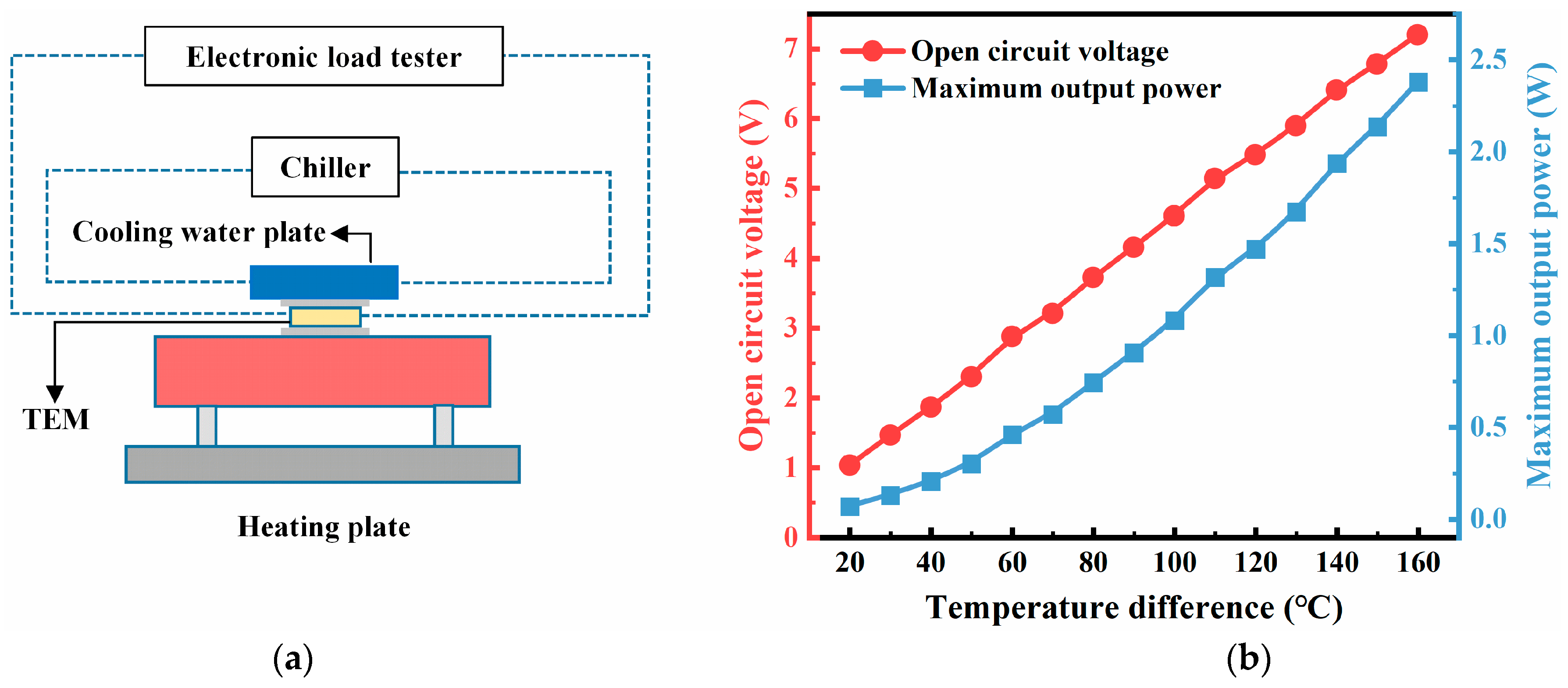


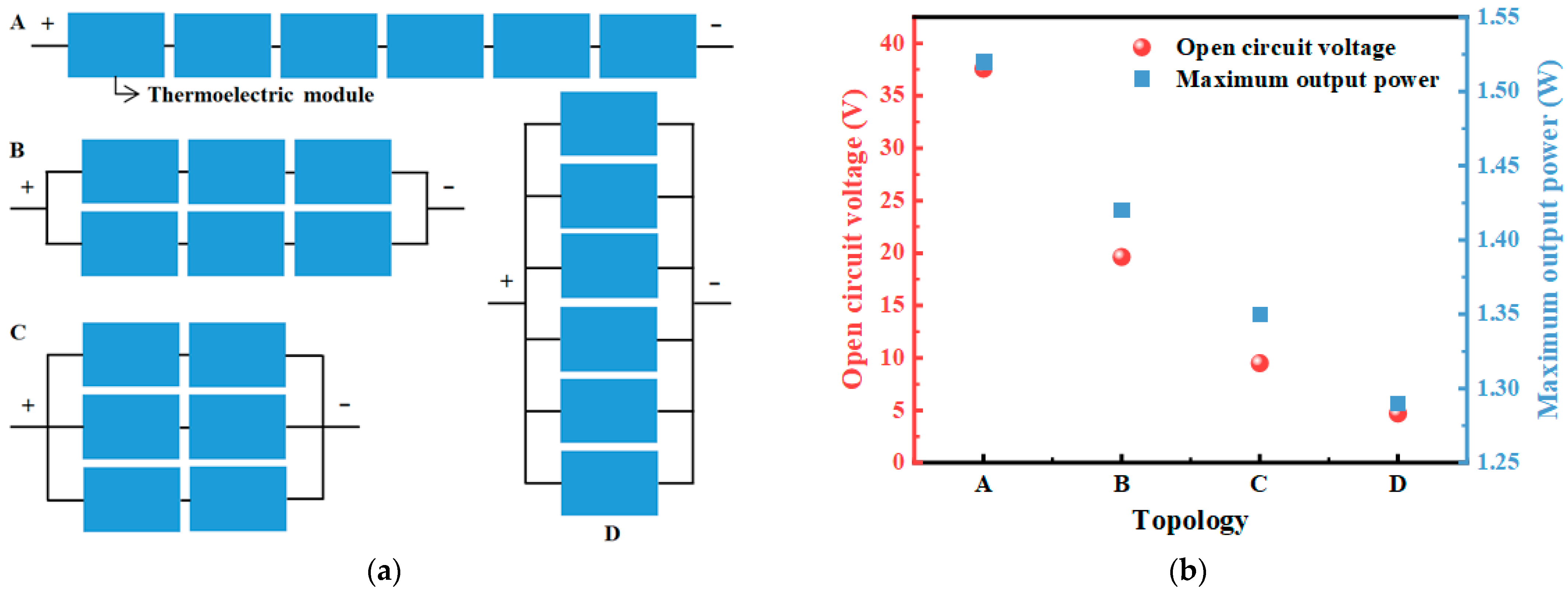
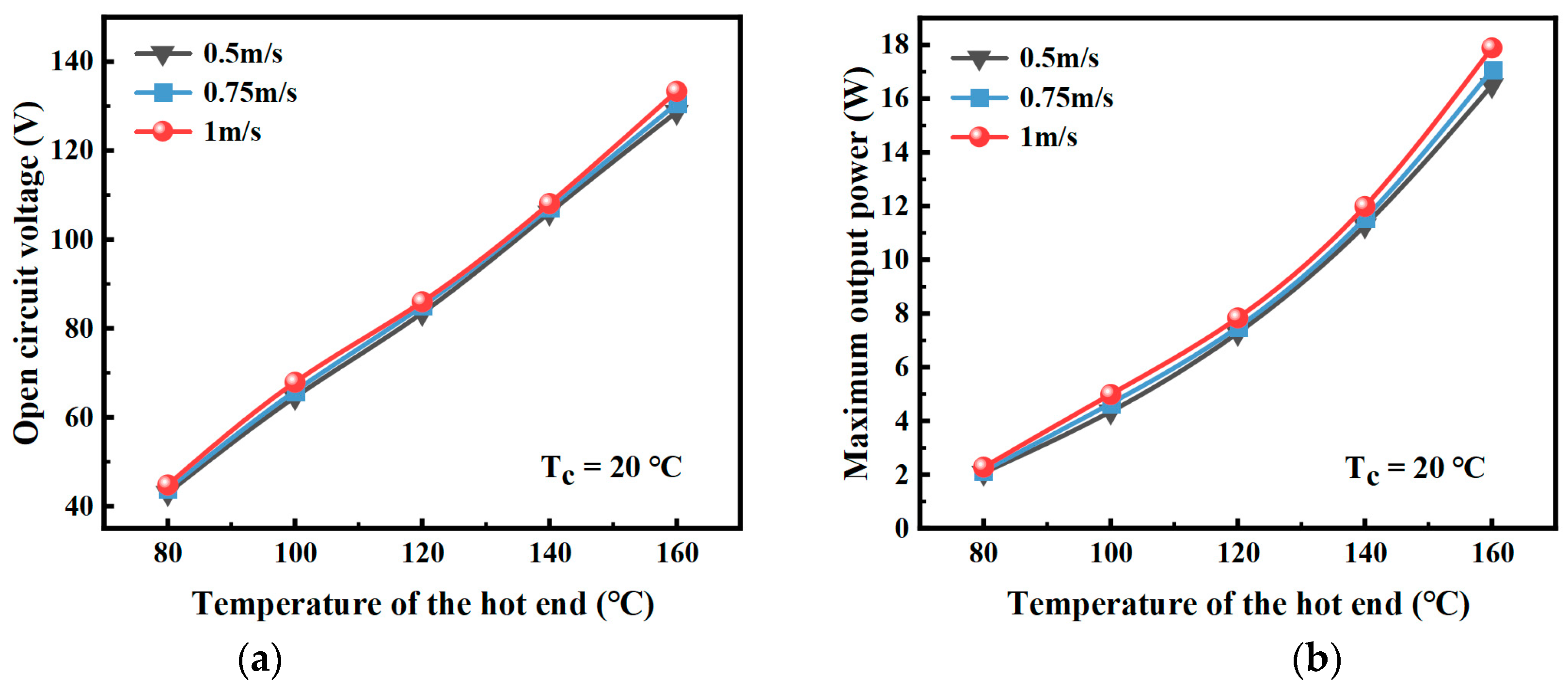
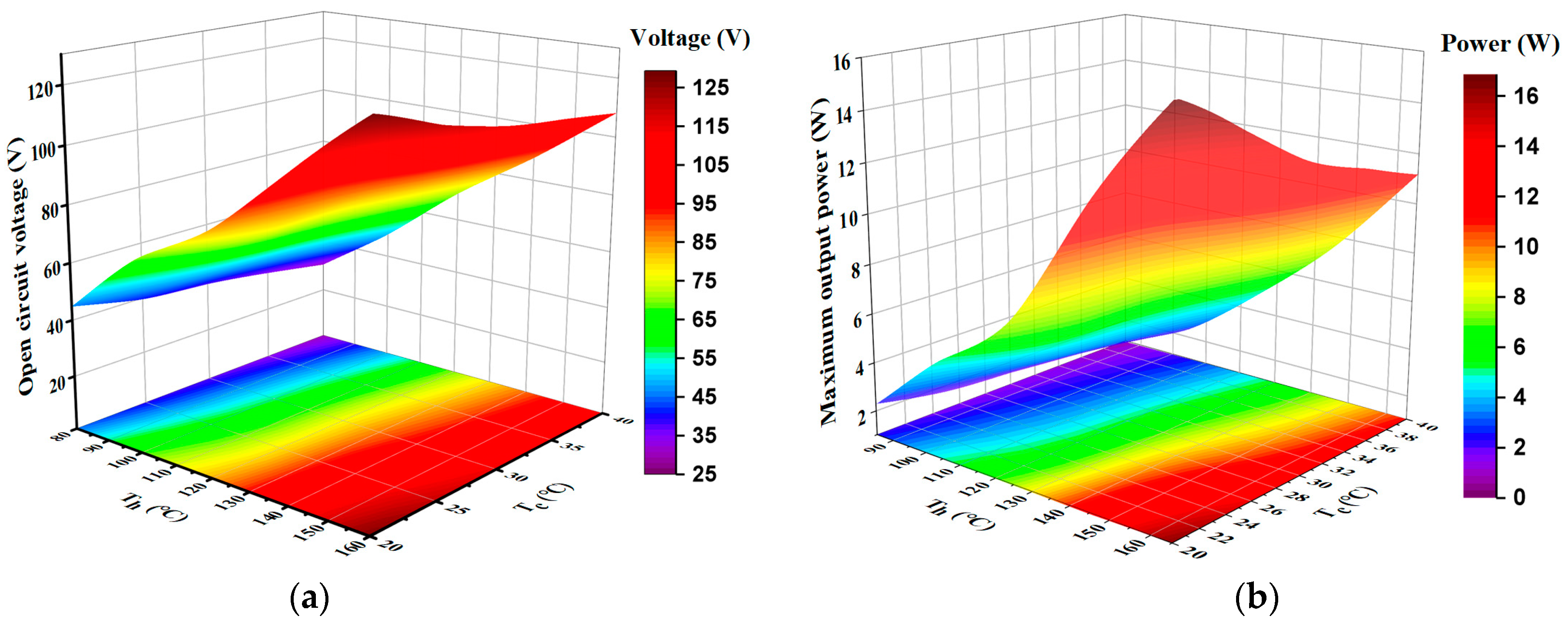
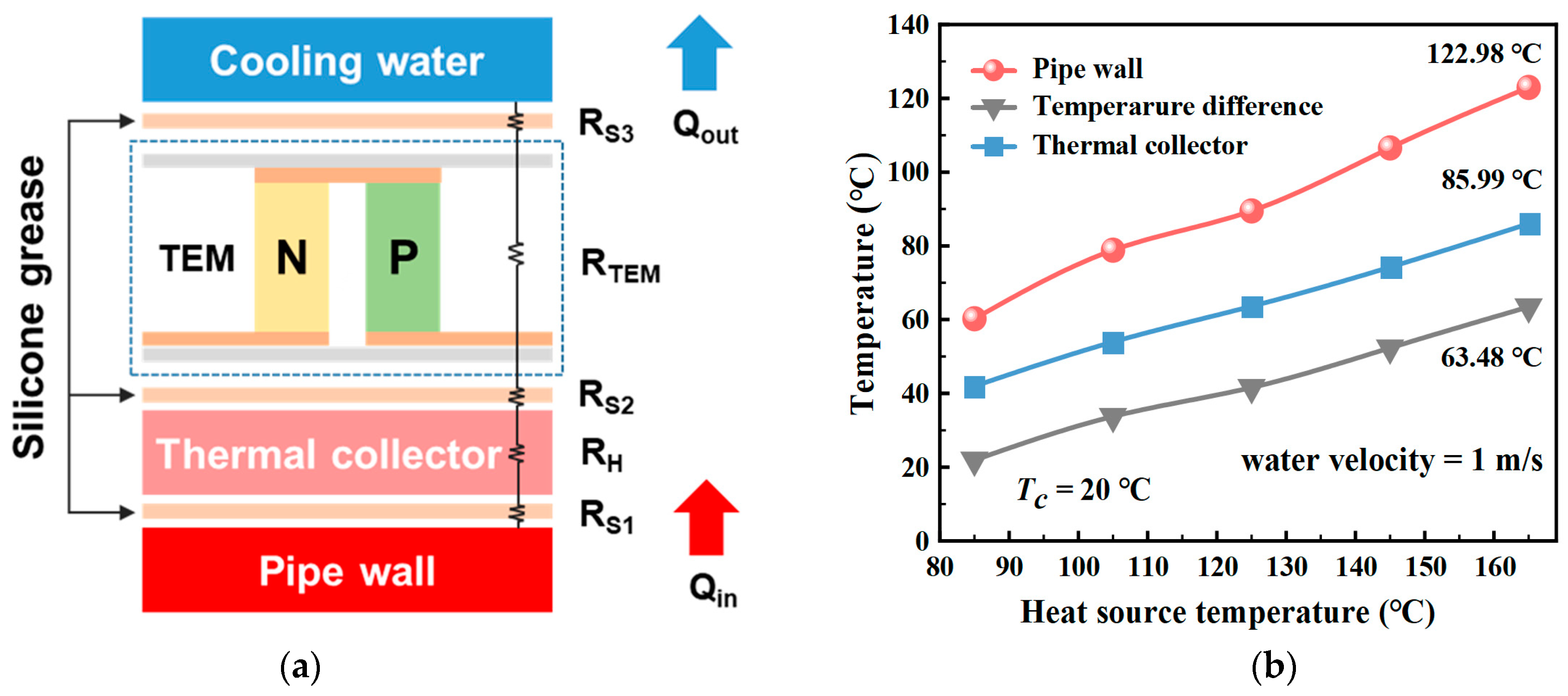

Disclaimer/Publisher’s Note: The statements, opinions and data contained in all publications are solely those of the individual author(s) and contributor(s) and not of MDPI and/or the editor(s). MDPI and/or the editor(s) disclaim responsibility for any injury to people or property resulting from any ideas, methods, instructions or products referred to in the content. |
© 2023 by the authors. Licensee MDPI, Basel, Switzerland. This article is an open access article distributed under the terms and conditions of the Creative Commons Attribution (CC BY) license (https://creativecommons.org/licenses/by/4.0/).
Share and Cite
Xiao, D.; Sun, P.; Wu, J.; Zhang, Y.; Wu, J.; Liu, G.; Hu, H.; Hu, J.; Tan, X.; He, S.; et al. Thermoelectric Generator Design and Characterization for Industrial Pipe Waste Heat Recovery. Processes 2023, 11, 1714. https://doi.org/10.3390/pr11061714
Xiao D, Sun P, Wu J, Zhang Y, Wu J, Liu G, Hu H, Hu J, Tan X, He S, et al. Thermoelectric Generator Design and Characterization for Industrial Pipe Waste Heat Recovery. Processes. 2023; 11(6):1714. https://doi.org/10.3390/pr11061714
Chicago/Turabian StyleXiao, Di, Peng Sun, Jianlin Wu, Yin Zhang, Jiehua Wu, Guoqiang Liu, Haoyang Hu, Jun Hu, Xiaojian Tan, Shi He, and et al. 2023. "Thermoelectric Generator Design and Characterization for Industrial Pipe Waste Heat Recovery" Processes 11, no. 6: 1714. https://doi.org/10.3390/pr11061714
APA StyleXiao, D., Sun, P., Wu, J., Zhang, Y., Wu, J., Liu, G., Hu, H., Hu, J., Tan, X., He, S., & Jiang, J. (2023). Thermoelectric Generator Design and Characterization for Industrial Pipe Waste Heat Recovery. Processes, 11(6), 1714. https://doi.org/10.3390/pr11061714










